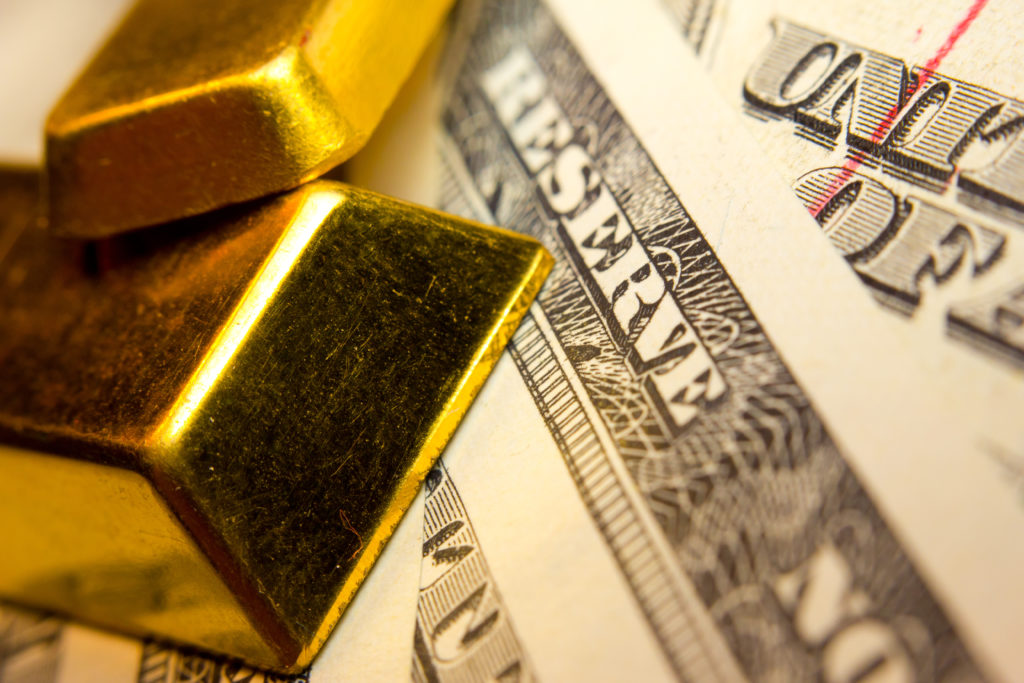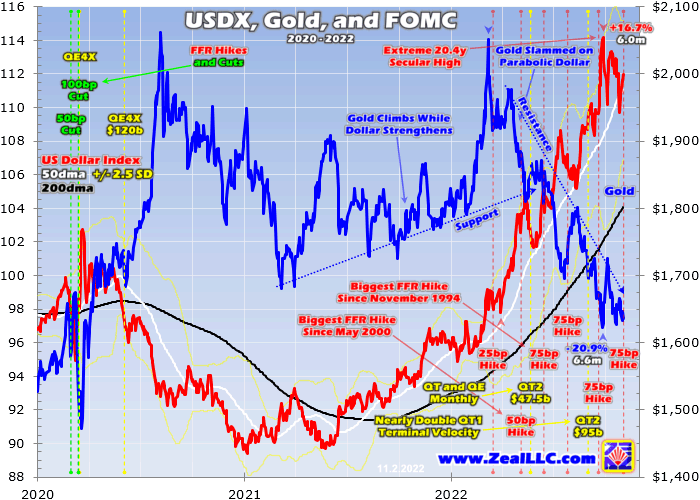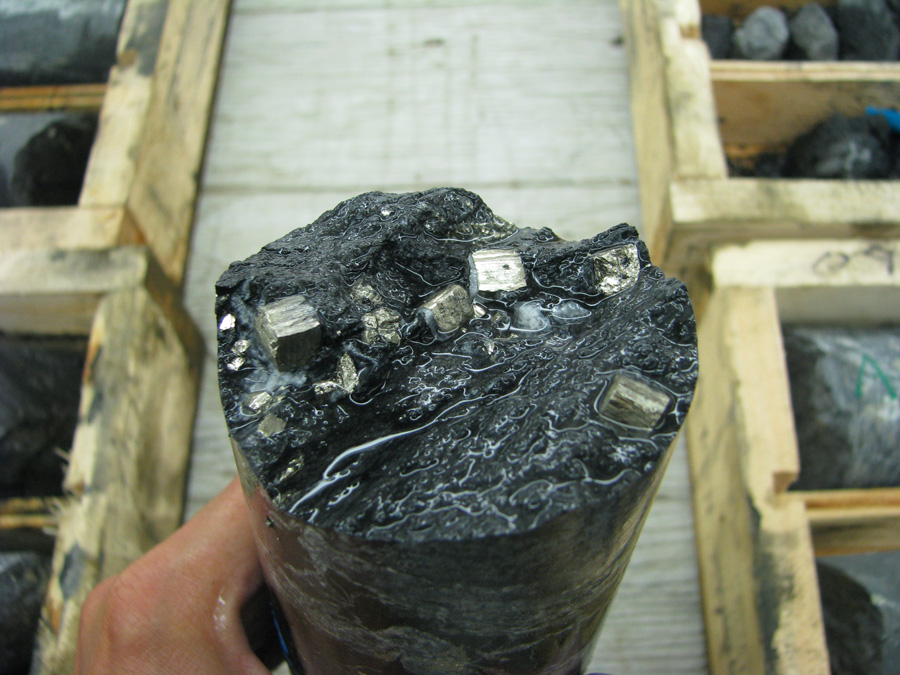Fed dollar/gold shock ending

The Fed continued its extreme tightening this week with another monster 75-basis-point rate hike. While that was universally expected, the Fed chair surprised waxing uber-hawkish at his post-FOMC-meeting press conference. That yet again shocked the US dollar and gold into sharp opposing moves. But the Fed’s ability to keep doing that is ending, since the lion’s share of its tightening firepower has been spent.
Wednesday’s latest monetary-policy decision by the Federal Open Market Committee was the sixth in a row seeing rate hikes. Top Fed officials unanimously approved their fourth huge 75bp one in as many meetings! Since mid-March, they have hiked their benchmark federal-funds rate 25bp, 50bp, 75bp, 75bp, 75bp, and 75bp. That first 75bp behemoth in mid-June was the FOMC’s biggest FFR hike since November 1994.
That adds up to an extraordinarily-extreme 375 basis points of hiking in just 7.6 months! During the Fed’s last rate-hike cycle in 2018, the most it dared boost the FFR was 100bp in an entire year. And this latest blistering hiking is even more radical since it erupted off a zero-interest-rate policy. That makes all this wildly unprecedented, an epic shock to markets. But this week’s FOMC statement finally looked dovish.
Fed officials added a major new qualifier on future rate hikes, “In determining the pace of future increases in the target range, the Committee will take into account the cumulative tightening of monetary policy, the lags with which monetary policy affects economic activity and inflation, and economic and financial developments.” Traders rejoiced, seeing that as a soft pivot ending this brutal streak of gargantuan 75bp hikes!
The leading S&P 500 stock index surged dramatically to 1.0% intraday gains. The benchmark US Dollar Index plunged about 0.9% on that sizable shift in monetary policy, a massive move for the world’s reserve currency. That ignited big gold-futures buying, catapulting the yellow metal 1.2% higher within a half-hour. But those big moves on a more-dovish-than-expected FOMC statement were soon reversed hard.
Fed chair Jerome Powell took the podium a half-hour after that decision. He has generally come across as more dovish than the FOMC in this year’s pressers. But with markets surging after that statement, this week Powell pushed back. He warned reporters the Fed isn’t even thinking about pausing rate hikes yet, and still has some ways to go in lifting its federal-funds rate into restrictive territory to slow this raging inflation.
The magnitude of this hawkish shock was evident in markets’ violent reactions. The S&P 500 plummeted from +1.0% to an ugly -2.5% close! That proved the US stock markets’ worst performance ever in the final 90 minutes of an FOMC day. The USDX skyrocketed from -0.9% to +0.4% on close, which slammed gold from +1.2% before Powell to -0.6% exiting the US trading day! Powell’s hawkish trapdoor was epic.
The US Dollar Index exited that exceedingly-wild Fed day at 112.0, just 1.9% under its extreme 20.4-year secular high in late September. Gold was pummeled back to $1,636, merely 0.8% above its own parallel deep 2.5-year low. The damage to gold psychology was serious, as evident in gold stocks’ brutal overreaction. Their primary GDX ETF plummeted 7.0% intraday after Powell’s comments to crater 5.9% on close!
Seeing extreme Fed hawkishness catapult the US dollar higher and crush gold lower is nothing new this year. So contrarian speculators and investors are getting ever more disheartened about gold’s prospects. Even though inflation is raging which is wildly bullish for history’s ultimate inflation hedge, traders are tired of fighting the Fed and failing. But the Fed’s ability to keep shocking the dollar and gold is coming to an end.
This chart shows recent years’ US Dollar Index and gold price action, overlaid with the FOMC’s monetary-policy decisions. The Fed’s most-extreme tightening cycle ever goosed the USDX into skyrocketing this year. That unleashed massive gold-futures selling pummeling the yellow metal sharply lower. But with top Fed officials running out of rate-hiking firepower, these colossal pricing anomalies must soon reverse.

As major currencies usually move with glacial slowness, the US Dollar Index’s blistering 16.7% soaring in just 6.0 months into late September is far beyond extreme! Hyper-leveraged gold-futures speculators look to the dollar’s fortunes as their primary trading cue. So as the USDX soared, they aggressively liquidated gold-futures longs and ramped shorts. That bludgeoned gold a miserable 20.9% lower in 6.6 months!
That dollar-surge-fueled extreme gold-futures puking is critical to understand, so I recently analyzed it in depth in a mid-October essay. Just as the Fed only has so much room to tighten, the capital firepower wielded by gold-futures speculators is finite. And they had reached their likely selling limits in late September, with total spec longs at an extreme 3.4-year low while total spec shorts hit an extreme 3.8-year high!
Speculators dumped an astounding 267.7k gold-futures contracts around that half-year span, equivalent to 832.7 metric tons of gold. The resulting serious gold plunge scared investors into following suit, adding to the downside pressure. Their identifiable selling as evident in the holdings of the dominant GLD and IAU gold ETFs added another 207.2t at worst. That added up to a mind-boggling 1,039.9t of gold selling!
That exceeded gold’s total global investment demand throughout all of 2021 in about half the time, so it’s no wonder gold prices cratered. But with speculators’ gold-futures selling exhausted, they’re out of capital firepower to keep pummeling gold lower on extreme Fed hawkishness. Gold’s late-FOMC-day plunge this week was actually fairly mild, insufficient to drive prices below late September’s deep panic-grade lows.
The epic US-dollar buying catapulting the USDX stratospheric this year is also largely spent. That is harder to quantify since all kinds of currency futures trade around the world. USDX and other dollar futures are seeing excessively-bullish speculator positioning, the polar opposite of the excessively-bearish bets in gold futures. Opposing futures extremes are also evident in the USDX’s largest component currencies.
Those are led by the euro at 57.6%, Japanese yen at 13.6%, British pound at 11.9%, and the Canadian dollar at 9.1%. Extreme futures selling has crushed all these competing major currencies to deep new multi-decade or even all-time lows! So just as US-dollar futures are overdue to see huge mean-reversion selling, opposing currencies are on the verge of massive normalization buying. This is very bearish for the dollar.
With those short-gold, long-US-dollar, and short-competing-currencies trades all wildly overcrowded, odds are these extreme moves couldn’t continue no matter what the Fed does. And the FOMC has run out of runway to keep shocking and awing with its epic tightening campaign. Again Fed officials have hiked the FFR an astounding 375 basis points in just 7.6 months! That magnitude and pace are unsustainable.
The FOMC actively manipulates its federal-funds rate into a 25bp target range. So the Fed’s ZIRP after March 2020’s pandemic-lockdown stock panic was actually the midpoint between 0.00% and 0.25%, or 0.125%. That colossal 375bp of tightening has catapulted the FFR up to 3.75% to 4.00%, or 3.875%. After every-other FOMC meeting, top Fed officials’ collective FFR outlooks in coming years are summarized.
While this week’s FOMC was an off one without a dot plot, at the previous meeting in late September these elite central bankers had forecast the FFR peaking at 4.625% sometime in 2023. That’s only another 75 basis points over current levels. So per Fed officials’ own latest prediction, fully 5/6ths of their entire rate-hike cycle is already done! That only leaves 1/6th spread out over coming meetings, not much to surprise.
But Fed officials may up their terminal FFR outlook in the next dot plot coming in mid-December. After this week’s hawkish surprise from Powell, FFR futures were pricing in it peaking around 5.125%. That’s really risky, probably enough to force this heavily-indebted US economy into a severe recession if not a depression! But even that implies just another 125 basis points of hikes left, only a quarter of that 500bp total.
So there’s no way this past half-year’s blistering pace of rate hikes will continue. The Fed will be forced to slow down sharply in the next couple FOMC meetings. In today’s crazy-extreme rate-hike cycle, the FFR has been hiked at an epic 49bp-per-month pace! That compares to monthly rates of 17bp, 18bp, and 6bp during the previous three hiking cycles. It’s simply impossible to maintain this current blitzkrieg hiking pace.
Not only is the Fed running out of room to keep hiking, but it can’t let rates stay high for long because they will bankrupt Americans, companies, and US governments. The US Treasury reports federal-government debt running $31,212b. It is currently paying average interest rates on outstanding bills, notes, and bonds near 2.5%, 1.6%, and 3.0%. Today’s FFR already near 3.9% is gradually forcing average Treasury costs higher.
Longer-term Treasury yields lag Fed rate hikes, not reflecting higher rates until older bonds mature and are replaced with new ones. Last fiscal year ending September 2022, the US government spent just 8% of its budget or $475b on interest. The kinds of terminal FFRs fed officials and traders are predicting now would easily more than triple that in coming years! Interest payments would crowd out other spending.
The US Federal Reserve certainly won’t risk bankrupting the US federal government, so these high rates can’t last for long given Washington’s staggering indebtedness. These blistering Fed rate hikes have also slammed the US stock markets into a serious bear this year, the S&P 500 plunging 25.4% at worst in just 9.3 months into mid-October! Anger at Fed officials is mounting, including from powerful US lawmakers.
Last week the Democratic senator leading the Senate Banking Committee which oversees the Fed wrote a public letter to Powell warning him on these crazy hikes. Senators are worried this extreme tightening will lead to widespread job losses, violating the maximum-employment side of the Fed’s dual mandate required by Congress. No matter how elections play out, political pressure on the Fed will only keep mounting.
The farther the FOMC hikes, the longer it holds the FFR high, the more stock markets fall, and the more resulting economic pain Americans feel, the harder it will be for top Fed officials not to capitulate. They actually caved ending their previous tightening cycle way prematurely in late 2018 for similar reasons. Like today’s, rate hikes then were accompanied by parallel quantitative-tightening monetary destruction.
Inflation isn’t raging today because the FFR was held artificially low. For 7.0 years into December 2015, the FOMC continuously kept ZIRP in place. Yet during those 84 months, the headline US Consumer Price Index inflation gauge averaged mere 1.4% year-over-year gains! The dominant reason the monthly CPI is skyrocketing an average of 8.3% YoY so far in 2022 is extreme Fed money printing fueled it.
Fed officials panicked during March 2020’s pandemic-lockdown stock panic, redlining their monetary printing presses. Over the next 25.5 months into mid-April 2022, the FOMC ballooned its balance sheet by a ludicrous 115.6% or $4,807b! Top Fed officials foolishly chose to more than double the US dollar’s monetary base in just a couple years. That unleashed the raging inflation these same guys are now fighting.
Legendary American economist Milton Friedman did a comprehensive study of US monetary history in the early 1960s, and famously concluded “Inflation is always and everywhere a monetary phenomenon.” Too much fiat money is conjured out of thin air and injected into the real economy, competing for and bidding up the prices on far-slower-growing goods and services. That excess money needs to be destroyed.
Between late 2017 to late 2018, the Fed’s original QT1 campaign gradually ramped up to a $50b-per-month terminal pace. The Fed’s current QT2 is far more aggressive, starting at $47.5b monthly in June 2022 before doubling to $95b just three months later in September. Top Fed officials have ramped QT2 to nearly double QT1’s final size in just a quarter the time! About 2/3rds of QT2 is allocated to US Treasuries.
Since late May, Treasuries monetized by the Fed have indeed declined by $161b. But had the FOMC stuck to its promised QT2 pace, closer to $222b should’ve been rolled off. In addition to dragging its feet on QT2 while catapulting the FFR vertical, QT2’s Treasury selling puts more upward pressure on long Treasury yields. That gives the FOMC a shorter leash to keep hiking before bankrupting the US government.
All traders who have piled on to the US-dollar-to-the-moon or gold-is-dead bandwagons over this past half-year or so have to realize this was all an extreme anomaly. Never before has the Fed hiked 375bp in six consecutive FOMC meetings off a ZIRP FFR while simultaneously ramping QT monetary destruction to its highest levels ever dared! And odds are no tightening this aggressive will ever be attempted again.
As this week’s FOMC statement acknowledged, top Fed officials can’t keep their monster 75bp hikes coming. They are running out of room nearing terminal FFR levels, while increasingly wreaking havoc in the US economy. And even if these panicking central bankers find the courage to run QT2 full-speed at its advertised $95b-per-month pace, it would take another 48 months to unwind that post-panic money spewing!
So this raging inflation will persist for years even if it moderates a bit on higher-base-effect comparisons. And with most of their rate-hiking ammunition already spent, top Fed officials’ ability to shock traders with hawkish surprises is ending. The FOMC can no longer surprise with bigger and faster rate hikes, as the terminal-FFR endgame nears! That means the US Dollar Index’s parabolic surge on those surprises is over.
This wildly-overcrowded crazy-euphoric extraordinarily-overbought US dollar trading near extreme secular highs is overdue to roll over hard in heavy mean-reversion selling. That has actually already started, as the USDX had been increasingly grinding lower since peaking in late September. Not even Powell’s big hawkish surprise this week could propel this leading dollar benchmark anywhere back up near those highs.
The USDX’s massive selloff will be accelerated by Fed-dovish revelations, either top officials’ Fedspeak or economic data likely to stay the FOMC’s hand on further rate hikes. The latter includes cooler-than-expected inflation data or weaker-than-forecast monthly US jobs reports. Exacerbating the dollar’s plunge back to earth will be that big parallel mean-reversion buying out of bearish extremes in competing currencies.
One of the main reasons the US dollar skyrocketed this year was the Fed was first out of the gates with uber-aggressive rate hikes. The resulting higher dollar yields opened up a big lead over the competition. But other central banks are rushing to catch up after a late start. The European Central Bank for example has hiked its benchmark rate 200bp in just 3.2 months, a crazy-fast 63bp monthly pace exceeding the Fed’s 49bp!
That is closing the yield differential between the euro and US dollar, and again that currency dominates the USDX weighing in at 57.6%. Big overdue rallies in the USDX’s components including the euro, pound, and Canadian dollar will accelerate the US dollar’s decline. That weaker USDX will unleash huge gold-futures mean-reversion buying, catapulting gold sharply higher and enticing investors back to amplify upside.
The last time speculators’ gold-futures positioning hit similar exceedingly-bearish extremes came in May 2019. With their selling firepower exhausted, all specs could do was buy to normalize their bets. So over the next 3.3 months, gold rocketed 21.5% higher! A similar move off late September’s stock-panic-level 2.5-year low could catapult gold back up near $1,975. Gold truly should be soaring given this raging inflation.
Thanks to the FOMC’s extreme money printing in recent years, we are now suffering the first and worst inflation super-spike since the 1970s. That deluge of new fiat money debasing the US dollar is rapidly eroding its purchasing power. This kind of dreadful highly-inflationary monetary environment eventually fuels huge gold investment demand as investors diversify their bleeding portfolios, launching gold far higher.
During the first inflation super-spike of the 1970s, the CPI blasted from +2.7% YoY to +12.3% YoY over 30 months into December 1974. Gold’s monthly-average prices from trough to peak CPI months soared 196.6% higher! During the second inflation super-spike, the CPI exploded from +4.9% YoY to +14.8% YoY in 40 months climaxing in March 1980. Gold’s monthly-average prices were a moonshot rocketing 322.4%!
With today’s latest monetary-excess-fueled inflation super-spike already seeing the lowballed CPI soaring 9.1% YoY at worst, gold ought to at least double this time around. The biggest beneficiaries of much-higher gold prices will be the brutalized gold miners’ stocks. Larger ones tend to leverage gold upside by 2x to 3x, while smaller ones fare way better. Fundamentally-superior miners are now trading at fire-sale prices.
The bottom line is the Fed’s recent dollar and gold shock is ending. After hiking an astounding 375 basis points in just six FOMC meetings, Fed officials are running out of room to keep going. Their federal-funds rate is nearing terminal-level projections, leaving little room for more hawkish surprises. Without those to keep goosing the parabolic US dollar, it is overdue to roll over hard in massive mean-reversion selling.
That weaker dollar will fuel huge normalization buying in gold futures, which have been driven to bearish extremes. Gold will power higher as inflation continues to rage, since the Fed needs years of monetary destruction to slay it. A strengthening gold bull will attract back investors, amplifying its gains as inflation ravages stock markets. The battered gold stocks will soar with gold, winning fortunes for contrarian traders.
(By Adam Hamilton)
More News
{{ commodity.name }}
{{ post.title }}
{{ post.date }}

Comments
steven k jones
You are foolish to say that the Fed cannot continue to raise interest rates. The fed will continue to raise rates until inflation ends and then it will maintain this high rate for some time for up to +12 months. The increasing of rates and increase in the dollar index are not tied at the hip.